|
Not exactly where you'd expect - that is, at what is today the Place de la Bastille. The main fortress was slightly west of that square, with walls and courtyards around it. The whole complex was right at the edge of Paris and the site of the current Place de La Bastille was largely occupied by a bastion - a pointed defensive structure which jutted out into the Faubourg St. Antoine, a suburb of Paris. If you walk east from one side of the Place de la Bastille to the other, you are walking between what was once Paris and what was once just outside it.
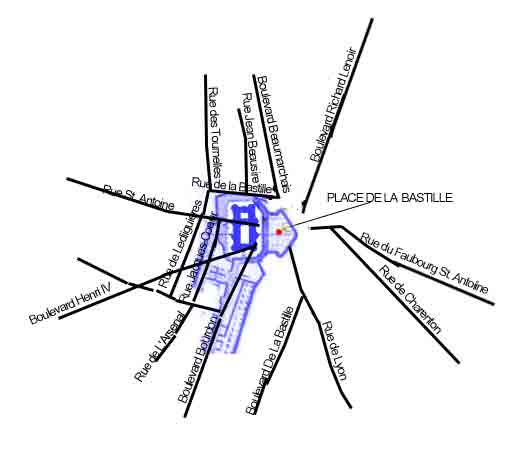
Approximate match of the Bastille complex's location to modern streets
If you're visiting Paris and want to get a frisson (that is, a cheap thrill) by tracing its exact location, things get complicated. Colored pavestones mark part of the old outline of the main castle, but there's more to it:
The castle best known as the Bastille was part of a larger complex, with several courtyards between the street entrance and the building itself. The Rue Lesdiguières (then the Passage des Lesdiguières), which runs north into the Rue St. Antoine, used to be a passage running along the outer wall of this complex, from the Rue de la Cerisaie to the Rue St. Antoine. The main entrance to the complex (on the Rue St. Antoine) was once across from the Rue des Tournelles (at a slight diagonal), just to the right of where the Rue Lesdiguières ends. The northern half of the Rue Jacques Coeur is in what was once the first courtyard of the Bastille complex. The Rue Jean Beausire once pointed to the two end towers of the old fortress (the Tour du Puits and the Tour du Coin) The angle formed by the start of the Rue des Tournelles and the Rue de la Bastille, which runs right until the Place de la Bastille (and should not be confused with the BOULEVARD de la Bastille), roughly traces the way the Rue St. Antoine once bent to go around the Bastille before ending in the St. Antoine Gate (Porte St. Antoine). The St. Antoine Gate itself was near where the Boulevard Beaumarchais meets the Rue de la Bastille. (When the Bastille was first built, the towers of the Chapel (Chapelle) and the Treasury (Trésor) served as the city gate, before the newer gate was built outside its walls.) The Boulevard Henri IV and the Boulevard Bourdon meet to the right of where the main gate to the fortress once opened, almost exactly at the old location of the Tour du Comté (the southeastern tower of the main fortress).
Bearing in mind that the Bastille was originally a defensive fortress built into the city walls, you can also envision the old battlements extending north and south from the main castle, curving inward as they progress.
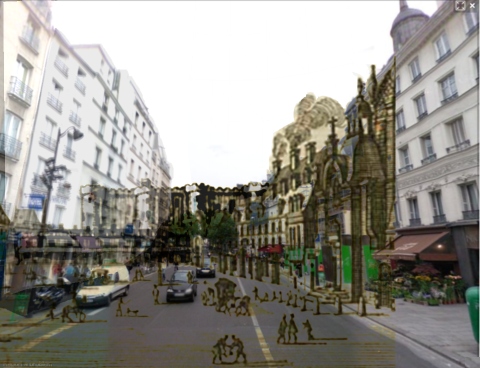
"The Ghost of the Bastille"
Viewed from the rue St. Antoine, which once veered off to the left at the outer walls of the Bastille, and on around it to the St. Antoine Gate. Part of the church at right still stands; today's Place de la Bastille is behind the fortress; the Rue de la Bastille is just to the left of this picture, where the outer walls end (the white buildings at left hide it, and would have hidden, in fact overrun, half of the Bastille itself, had they been there); the St. Antoine Gate once stood just beyond the rue de la Bastille.
Hover over the picture to "uncover" the rest of the Bastille.
FULL LAYOUT OF THE BASTILLE
By (or more probably ordered by) Payot,
the entrepreneur who directed the castle's demolition
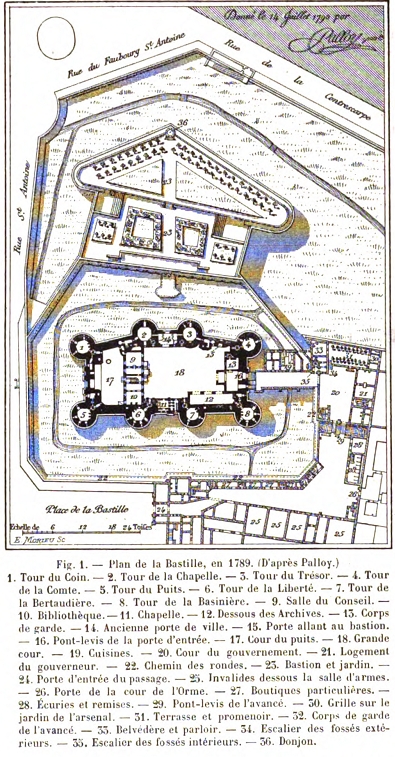 |
1 Corner Tower
2 Chapel Tower
3 Treasury Tower
4 County Tower
5 Well Tower
6 Liberty Tower
7 Bertaudière Tower
8 Basinière Tower
9 Council Chamber
10 Library
11 Chapel
12 Underneath the Archives
13 Watch post
14 Old city gate
15 Gate to bastion
16 Drawbridge to entry gate
17 Well courtyard
18 Large coutryard
19 Kitchens
20 Governor's courtyard
21 Governor's lodging
22 Rounds path
23 Bastion and garden
24 Entry to passage
25 Invalid soldiers below weapons room
26 Gate to the Orme courtyard
27 Individual shops
28 Stables and storehouses
29 Forward drawbridge
30 Grate on the arsenal garden
31 Terrace and walk
32 Advance watch post
33 Lookout and parlor
34 Stairs to exterior moats
35 Stairs to interior moats
36 Dungeon (tower)
|
About the image at the top: The 'logo' for this site is taken from one of many drawings that show the Bastille from outside the city walls. This is the eastern side, which once faced the bastion - that is, what today is the Place de la Bastille. The arcade in the middle was once both the entrance to Paris (the Porte St. Antoine) and to the main castle. But by the eighteenth century it had been walled up, and the entrance to the main building was at the southern end of the building - that is, just to the right of the tower leftmost (farthest from the viewer) in this picture. The Porte St. Antoine was moved outside the Bastille entirely, past the rightmost tower in this picture.
|

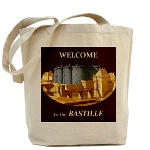 or mug:
or mug: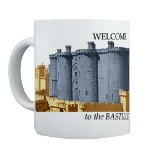 ?
? 


